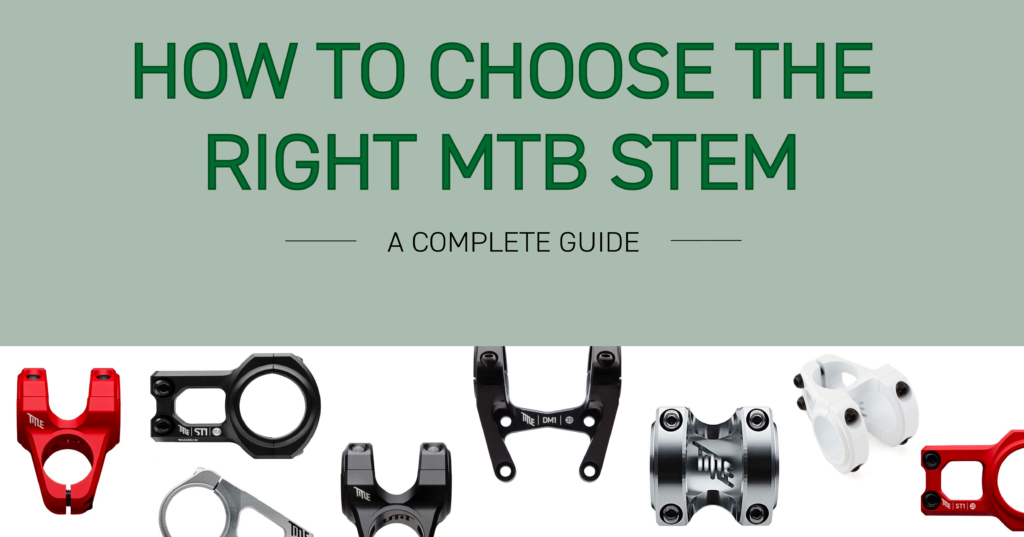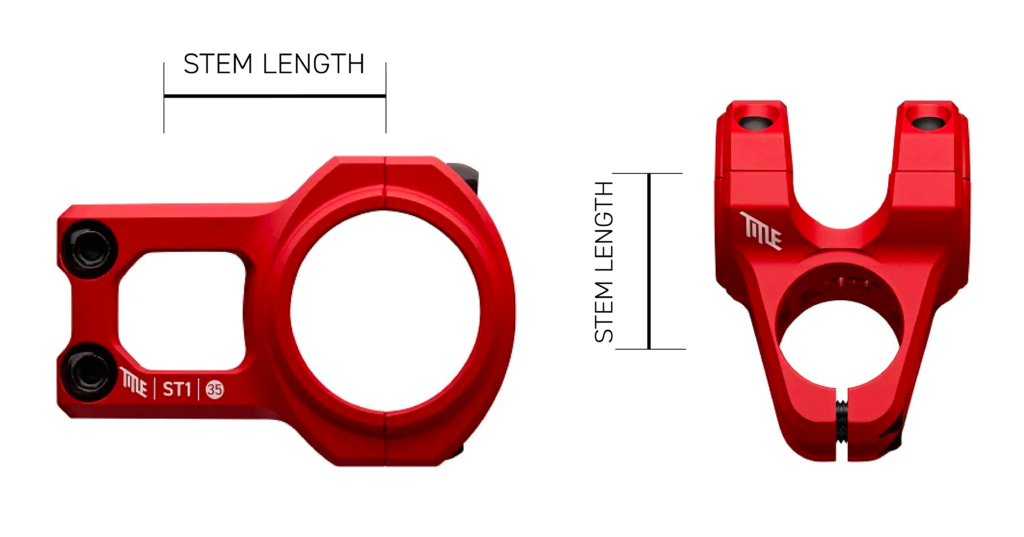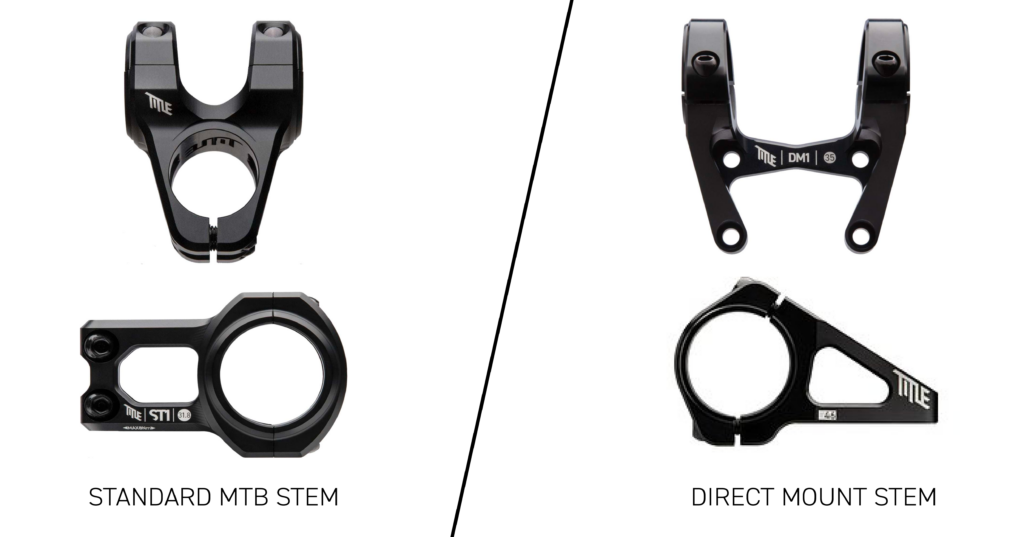How to Choose the Right MTB Stem
Choosing the right mountain bike stem is crucial for achieving proper bike handling and comfort on the trail. The stem's length, rise, and other factors can significantly impact your riding experience. In the following article we are going to go over all of the factors and steps to help you choose the right MTB stem.
HOW TO CHOOSE THE RIGHT MTB STEM
Before we get into the nuts and bolts of how to choose the right mountain bike stem, we wanted to go over stem length and rise in a quick overview below:
Stem Length
The length of a mountain bike stem refers to the measurement of the stem from the center of the handlebar clamp to the center of the steerer tube clamp. In other words, it is the distance along the stem from where the handlebars attach to where the stem attaches to the fork's steerer tube.
This measurement is typically expressed in millimeters (mm) and is a crucial factor in determining the rider's reach and riding position on the bike. Stem length significantly affects how far you need to reach to grasp the handlebars and, consequently, your overall riding comfort, control, and handling characteristics.
Stem Rise
The rise of a mountain bike stem refers to the angle at which the stem rises or tilts upward from the steerer tube. It is measured in degrees and indicates how much the handlebars will be elevated relative to the horizontal plane when the stem is installed. Positive rise, zero rise, and negative rise are the common rise options for stems, although most mountain bike riders will typically ride with a zero or negative rise. The choice of stem rise plays a significant role in determining your riding posture, comfort, and handling characteristics on the bike.
1. Determine Your Riding Style:
Choosing the right MTB stem relative to your riding style is crucial for achieving the optimal balance of comfort, control, and efficiency. Here are some general guidelines for selecting the appropriate stem based on your specific riding style:
1. Cross-Country (XC) Riding:
- Stem Length: Consider a longer stem (80mm to 100mm) to achieve a more stretched-out riding position. This can help with pedaling efficiency and climbing. However, don't go too long, as it can negatively affect handling on technical descents.
- Stem Rise: A low or zero-rise stem is typical for XC riding to maintain a low front end for aerodynamics and efficient climbing.
2. Trail Riding:
- Stem Length: Trail riders often prefer a balanced approach. Stems in the range of 50mm to 80mm are common, providing a combination of stability and maneuverability.
- Stem Rise: A stem with a slight rise (e.g., 5-10 degrees) can offer a comfortable riding position without being too aggressive or too upright.
3. Enduro Riding:
- Stem Length: For enduro riders, shorter stems in the range of 35mm to 60mm are popular. This setup allows for better control on technical descents while still providing sufficient stability.
- Stem Rise: A stem with a modest rise (around 0-10 degrees) can maintain a balanced riding position for enduro-style riding.
4. Downhill (DH) Riding:
- Stem Length: Downhill riders typically opt for the shortest stems, often 35mm or less. This setup maximizes control on steep descents.
- Stem Rise: Choose a stem with a low or negative rise (0-5 degrees) to keep the handlebars low and maintain an aggressive, weight-forward riding position.
Remember that these are general guidelines, and personal preference plays a significant role in stem selection. It's essential to experiment and fine-tune your setup to find the stem length and rise that best suits your comfort and control needs on the specific trails and conditions you encounter.
2. Sizing Considerations
1. Stem Length:
- The stem length determines how far your handlebars are from the frame. As mentioned above, longer stems provide a more stretched-out and aggressive riding position, while shorter stems offer a more upright and comfortable position. Choose a stem length that complements your body proportions and riding style.
2. Stem Rise:
- Stem rise refers to the angle at which the stem rises from the steerer tube. Stems can have a positive (rise), neutral (zero rise), or negative (drop) angle. The choice of stem rise affects your handlebar height. A positive rise lifts your handlebars, while a negative rise lowers them. Consider your desired handlebar height when selecting the rise.
Positive Rise
A stem with a positive rise angle tilts upward from the steerer tube. This results in the handlebars being higher than the top of the steerer tube. Positive rise stems are used to raise the handlebar height, which can lead to a more upright and comfortable riding position. They are commonly found on bikes where rider comfort and control are prioritized, such as on many trail and recreational MTBs.
Zero Rise
A stem with zero rise has no upward or downward angle. The handlebars are level with the top of the steerer tube. Zero rise stems are often used in cross-country (XC) and enduro/all mountain setups, as they maintain a low, aerodynamic position that can be beneficial for efficiency and climbing performance.
Negative Rise (Drop)
A stem with a negative rise angle tilts downward from the steerer tube. This results in the handlebars being lower than the top of the steerer tube. Negative rise stems are used to achieve a more aggressive and forward-leaning riding position. They are typically favoured by downhill and enduro riders who prioritize control and weight distribution toward the front wheel for steep descents.
3. Handlebar Compatibility
Ensure that the stem you choose is compatible with your handlebar's clamp diameter. The most common clamp diameter for MTB handlebars is 31.8mm, but some downhill setups use a 35mm diameter, which is still very popular. Make sure the stem and handlebar match in this regard. For example, a 31.8mm stem will require a 31.8mm handlebar, while a 35mm stem requires a 35mm handlebar. This is very important as the stem and handlebar will not be compatible if they do not match in this regard.
31.8mm Stem Clamp Diameter:
A 31.8mm stem clamp diameter is the more traditional and widely used size for MTB handlebars. It has been the standard for many years and is still the most common size on the market. You'll find a wide range of handlebars and stems available in the 31.8mm size, including various shapes, materials, and designs to suit different riding styles and preferences.
35mm Stem Clamp Diameter:
In recent years, a larger 35mm stem clamp diameter has emerged as an alternative standard. It was introduced to provide additional stiffness and strength in the connection between the handlebar and stem. The larger diameter of a 35mm handlebar clamp is believed to offer increased stiffness, which can benefit riders who prioritize precise handling and control, particularly in aggressive or technical terrain. While 35mm handlebars and stems have gained popularity, the selection of components in this size may not be as extensive as that of the traditional 31.8mm standard. However, the availability of 35mm components continues to grow.
4. Standard MTB Stem vs. Direct Mount Stem
Direct mount stems and standard MTB stems are two different types of stems used on mountain bikes, each with its own set of advantages and applications.
Standard MTB Stem:
- Clamp Style: Standard MTB stems are designed to clamp onto the steerer tube of the fork and the handlebar. They have a single clamp for the handlebar, usually in the center of the stem.
- Compatibility: Standard stems are compatible with most mountain bike forks and handlebars, making them versatile and widely available.
- Adjustability: Standard stems come in various lengths and rises, allowing riders to fine-tune their riding position. You can choose a stem length and rise that best suits your comfort and control preferences.
- Swappability: Standard stems can be easily swapped out if you want to experiment with different lengths or angles.
- Common Application: Standard stems are commonly found on XC, trail, enduro, and all-mountain bikes. They offer a range of options to cater to different riding styles and preferences.
Direct Mount Stem:
- Clamp Style: Direct mount stems attach directly to the fork's crown or the handlebar clamp area. They eliminate the need for a traditional stem that clamps around the steerer tube.
- Stiffness: Direct mount stems are known for their increased stiffness and strength due to their direct attachment to the fork crown or handlebar clamp area. This can result in improved steering precision and control.
- Weight: Because direct mount stems eliminate the need for a separate stem body, they can be lighter than standard stems. This weight savings can be beneficial for riders looking to reduce the overall weight of their bike.
- Downhill Focus: Direct mount stems are commonly used in downhill riding, where stiffness and control are paramount. The reduced flex can enhance handling in aggressive and technical descents.
- Limited Compatibility: Direct mount stems are not as widely compatible as standard stems. They are often designed specifically for certain fork models or handlebars, so compatibility can be limited. An example is a standard stem cannot be used on a triple crown fork, while a direct mount stem can. Alternatively, a standard stem can be used on a single crown fork, while a direct mount stem is not compatible.
- Adjustability: While direct mount stems offer some adjustment options, they are less adjustable in terms of stem length and angle compared to standard stems.
5. Other Considerations
Terrain and Riding Conditions
Consider the type of terrain you'll be riding on and the specific challenges you'll encounter. For example, cross-country riders may prefer a longer stem for improved climbing efficiency, while downhill riders may opt for shorter stems for better control.
Personal Comfort and Fit
Pay attention to your comfort on the bike. If you experience discomfort or strain in your neck, back, or arms, your stem length and rise may need adjustment. Experiment with different stem lengths and rises to find the right fit for your body.
Trial and Error
It's often helpful to try different stem lengths and rises to determine what works best for you. Some riders may prefer a more aggressive setup with a longer, lower stem, while others may prefer a more upright and comfortable position.
Our Take
Choosing the right mountain bike stem is a personal decision influenced by your riding preferences and body characteristics. It may take some experimentation to find the perfect fit, so don't be afraid to make adjustments and try different options to see what works best for you. Remember to weigh in all of the factors from this article and you should have no problem finding the stem that is most suitable for you.
Looking to upgrade your mountain bike stem? We have both standard and direct mount stems in stock from Title MTB. Click here to shop our full selection of mountain bike stems. Remember that we offer free shipping on all orders over $149CAD in North America. Spend less and ride the best with TBS Bike Parts!
Related Articles
HOW TO CHOOSE THE RIGHT MTB HANDLEBAR
ALUMINUM VS. CARBON MTB HANDLEBARS – ADVANTAGES & DISADVANTAGES
TITLE MTB RED & WHITE COMPONENTS NOW AVAILABLE
VERTICALLY COMPLIANT MTB HANDLEBARS – ALL YOU NEED TO KNOW
MAXXIS MTB TIRE MODELS – WHICH ONE IS RIGHT FOR YOU?
HOW TO CHOOSE THE RIGHT MTB FLAT PEDALS
HOW TO CHOOSE THE RIGHT MOUNTAIN BIKE TIRE



